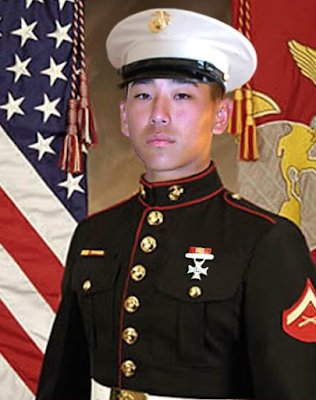FOR REP. JUDY CHU, this piece of legislation was intensely personal.
"Harry Lew was a Marine stationed in Afghanistan. One midnight, his peers took it upon themselves to administer what they called 'corrective training,' said Chu.
"They berated him, ordered him to dig a foxhole, and forced him to do useless exercises carrying his heavy full-body armor and a 25-lb sandbag. They stomped on his back, kicked and punched him, and poured the entire contents of a sandbag onto his face and in his mouth. It lasted a full 3 ½ hours.
"Finally, 22 minutes after they stopped, Harry killed himself with his own gun. He was 21 years old. He was my nephew."
 |
| U.S. Marine LCpl. Harry Lew |
"This is the fifth anniversary of the death of my nephew, and justice certainly wasn't served," said the Southern California congresswoman. "Of the three that were involved, two were let go without any punishment, and one was put into one month confinement. So it is time for the military to treat hazing seriously. Our men and women in uniform protect us and we must do what we can to protect them."
She introduced a bill on April 26 to require the Pentagon to track and make annual reports on the problem on hazing in the military. The Harry Lew Military Hazing Accountability and Prevention Act is named in honor of Rep. Chu’s nephew. It is cosponsored by Reps. Jackie Speier, Debbie Dingell and Ted Lieu. This bill would require the Pentagon to create a database of hazing incidents in the military and to submit an annual report on what is being done to stop hazing through training and response.
This follows a report by the Government Accountability Office (GAO) released in February that showed that the Department of Defense lacks consistent data on military hazing incidents, and that servicemembers across branches are in need of better training to combat hazing. The GAO report was the result of an amendment Rep. Chu included in the 2015 National Defense Authorization Act (NDAA).
Today, April 27, Rep. Speier, a member of the House Armed Services Committee, introduced the text of the Harry Lew Military Hazing Accountability and Prevention Act as an amendment to the 2017 NDAA during the Committee markup of the legislation. Reps. Chu, Speier, Dingell, and Lieu released the following statements:
“Hazing has no place in our military. It breeds fear and distrust within the ranks," said Rep. Chu.“The GAO report released earlier this year showed that the Pentagon’s guidance on hazing is unclear and imperfectly applied. Each military branch has a different standard for what qualifies as hazing, and oversight is rare. I believe that without an accurate system of tracking incidents, we have no way of actually knowing the full extent of the problem. Failure to implement clear anti-hazing policies is costing lives, and that is unacceptable. It is time the military treat this problem seriously. We must move this bill forward so that we can provide the protection and support our troops deserve.”
“We hear too many stories of hazing that harm soldiers’ mental health, can cause serious injury, diminish unit cohesion, and even cost lives,” said Rep. Speier. “Unfortunately, for all these tragic examples, we still lack a clear understanding of hazing and the military’s response. The creation of a database of reported incidents of hazing, implementation of surveys, and the implementation of new anti-hazing training are the least we can do to ensure progress is made to fight hazing.”
“I have been working with the Marine Corps on the tragic death of Private Raheel Siddiqui of Taylor, Michigan at Parris Island during boot camp,” said Rep. Dingell. “This was an intelligent, loyal, patriotic young Muslim man – and class valedictorian – who loved his country. Some are concerned that hazing may have been involved in the death of Private Siddiqui. NCIS is investigating the circumstances surrounding this tragedy, and their report will help provide the facts of what happened. We all have an obligation to bring more accountability to the system ... We owe it to those we’ve lost to take action to prevent more senseless tragedies from happening in the future.”
“As a former active duty officer in the U.S. Air Force and a current Lieutenant Colonel in the Air Force Reserves, I am proud to join Congresswoman Judy Chu as an original cosponsor of the Harry Lew Military Hazing Accountability and Prevention Act,” said Rep. Lieu. “Through enhanced reporting, tracking, and training, this legislation sends a clear message that hazing and bullying have no place in our military. Our brave men and women serving in uniform must be able to focus on the mission at hand knowing that the U.S. Armed Force’s anti-hazing policies do not exist on paper but are enforced."
The text of the bill can be found here.
###
For more news about Asian/Americans & Pacific Islanders, read AsAm News.



















